By Pete Hiatt
The steelhead/sea run cutthroat flies are the simple
American cousins to the Brit's artistic Atlantic Salmon
Flies. The American versions are easier to tie and very
effective. The variations within these are simple. There
are bright colors and dark colors with both sparse and
thick bodies. There are two basic versions within this
group: the hair wing like the Skykomish Sunrise or Royal
Coachman and the feather wing like the Spruce Fly. Marabou
feathers, synthetics, and different body types make for
innumerable variations, but learning to tie the two basic
types covers all but the specialty flies.
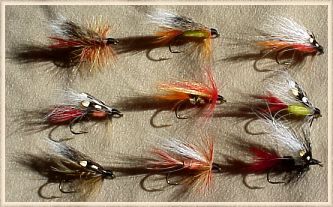
There are differences in the effectiveness of the same fly
between cutthroat, steelhead and salmon. 40 years of fishing
for them has led to me to tie all Sea Run Cutthroat flies
with thick bodies. They are just more effective for me, day
in and day out. The most important difference between the flies
for cutthroats and steelhead are in how you tie the hackle and
wings on the fly. Stiff, full hackle allows the fly to stay
closer to the surface with greater ease. This is very effective
for cutthroat which seem to prefer the fly up high in the water
regardless of the depth of the water. The wings can also be tied
under the hackle which also allows the fly to stay up a bit higher.
Tying the wings over the hackle streamlines the fly a bit more
and lessens the effectiveness of the hackle to keep the fly high
in the water. The spey-type tied flies take this a bit further
with soft, sparse hackle. They are more minnow-like in
presentation and stay lower in the water with greater ease.
They are gaining in popularity and are effective, but I
personally don't much care for the look.
So for cutthroats, keep thicker bodies and higher flies.
Under overhanging brush, by stumps, over rocks are all
good areas. I prefer fishing for them in tidewater just
below the head of tide. The cutthroats usually stay in
this area for a long period of time awaiting fall rains.
The bright colors are best during the day and dark patterns
are best under low light level conditions.
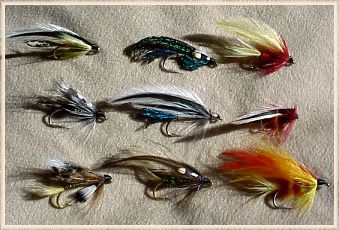
I have found steelhead to be more selective. While some water
conditions and time of day call for sparser or more subdued
colors (ie, purple & black or brown tones), the average
steelhead fly revels in being a loud and gaudy thing. They
and the cutthroat flies are the Phyllis Dillers of the fishing
world. Still, darker versions prevail in the barely legal
twilight evening hours just prior to the dinner bell and
lighted fly bench. At these times, the darker forms are
easier for the fish to see against the surface. The steelies
like their presentations lower in the water so tie and fish
accordingly. Steelies are usually caught above the head of
tide and the water is often shallow and very clear. Sparser
patterns are often effective at these times. Remember that
the sparseness is important when the fly is WET. Marabou
looks full but is very streamlined in the water. It adds
seductive movement, also. The dark/light rules still apply.
My fly fishing life began when an alleged friend swiped my
uncle's boat before I could one day and came back to shore
with a chest full of cutthroats caught on fly. Then my uncle
showed up and instead of chastising him, we had him guide
us with a couple of extra fly rods he had handy (I have
learned never to turn down an oarsman). That was the start
of my downfall into fly fishing. Flies available from the
local shop fell apart too easily so I started tying my own.
I put myself through college engineering tying and guiding
on coastal rivers. An early retirement found me easy prey
to more of the same affliction.
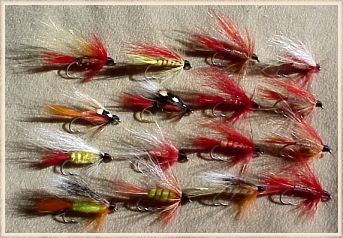
My cutthroat/jack/salmon fly fishing was done from boat and
just under the surface so very few flies were lost. In the less
than perfectly clear salt water, the fish didn't care if I used
4 pound line or 20 pound line. I found that out by experimentation.
I settled on 8 pound line which I still use today. It will handle
a Chinook salmon. Since I lost very few flies fishing this way,
the search for the perfect and indestructible fly began. The
store bought flies came apart or quickly rusted in the upper
saltwater reaches of Oregon's Alsea River which was local to
me. We fished just below the head of tidewater where the
cutthroats were always present in this shortish coastal
river. Tying my own flies became a necessary requirement.
I found the excellent Eagle Claw #1197 in nickel and gold
which solved the rusting problem. That hook is still made
40 years later, although it is no longer $20/1000. The hook
could be slightly filed sharper without going through the
nickel coating. The hook was also very strong and held up
with even the occasional Chinook salmon. Chinook can flat
straighten out a normal hook. I tied in #8, #6, and #4 sizes.
Pattern choice really was not very important. We were not
matching a hatch and the anadromous fish were not sophisticated.
They usually wanted BRIGHT!

The two most popular patterns of the day were the Skykomish
Sunrise and the darker Spruce flies. I tied and used both
effectively, but the Skykomish Sunrise was longer lasting
than the feather winged Spruce fly. The Skykomish Sunrise
was chosen as the basis for the "perfect steelhead/cutthroat
fly." The hook was only the first change. Experience had
shown that a thicker body was more effective in catching fish
(especially cutthroat and salmon) so built up bodies were next.
The chenille body was the next target. It abraded away far
too easily with fish teeth, debris in the water (always
bothersome on incoming tides), and the always present and
vicious Attacking Brush. I switched to yarn bodies. The
teeth of the fish sometimes even broke the ribbing tinsel
so tinsel usually became history. Instead, I switched to
wire and half-hitched in between each wrap of yarn to keep
it from sloughing back on the hook from repeated fish attacks.
One of these lasted an entire fishing season for me which
included several steelhead and jack salmon, many dozens
of sea run cutthroats and a particularly nasty 33 pound
Chinook who had been determined to prove the "indestructible"
part wrong.
 About the only thing I have changed in 40 years is to add marabou
for extra life and attraction. I tie on the marabou a bit behind
the hackle/wing tie to reduce head size.
About the only thing I have changed in 40 years is to add marabou
for extra life and attraction. I tie on the marabou a bit behind
the hackle/wing tie to reduce head size.
The second major variety is the feather-winged fly as exhibited
by the Spruce fly. I prefer the wings to be 50% longer than the
fly hook to add more life. There are many effective variations
of this fly, but the easiest to tie and murderous in its catching
abilities is my brightly colored Marabou Spruce. I use the same
nickel #1197 hook with no body at all. The silvery hook provides
its own attraction. The marabou, then hackle then feather wing
is all tied at the head of the fly. That's it...IT'S DONE!

For novice casters, please note that if you start your forecast
before the back cast is completely straightened out, the fly will
"pop" and the wet marabou which casts easily will then lose its
wetness and puff out creating so much air drag, you'll think you
are casting a balloon. So complete the backcast first! Otherwise
forget that presentation nonsense. We are talking about neolithic
fish here not sissy fish. Cutthroat will immediately retake a
fly after several encounters with the hook. They are bulldogs!
As in most fly fishing, disgustingly few patterns will suffice.
Light, dark, sparse, and full bodied covers everything. I find
no reason for more than a Skykomish Sunrise, Pete's R&B or RBW,
Pete's Rogue River, and an R&Y Marabou Spruce. Marabou added
to any pattern helps, although, a chunk of worm added sometimes
is even better.
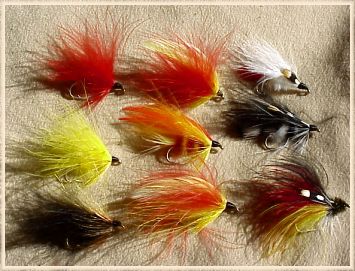
The patterns mentioned will be in the FAOL Atlantic series here,
keep checking back. For complete tying instruction on the
fishing version of the Skykomish Sunrise (with Marabou),
click
HERE. ~ Pete Hiatt
Back to Index
|
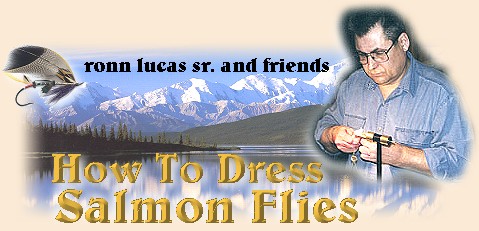





 About the only thing I have changed in 40 years is to add marabou
for extra life and attraction. I tie on the marabou a bit behind
the hackle/wing tie to reduce head size.
About the only thing I have changed in 40 years is to add marabou
for extra life and attraction. I tie on the marabou a bit behind
the hackle/wing tie to reduce head size.